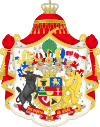House of Mecklenburg
| House of Mecklenburg | |
|---|---|
Adolphus Frederick VI (Strelitz) | |
| Titles |
|
| Estate(s) | Mecklenburg-Strelitz |
The House of Mecklenburg, also known as Nikloting, is a
Origin
The family was established by
Coats of arms

Each field in the coat of arm symbolizes one of the seven high lordly dominions of the state of Mecklenburg: upper-left quarter:
-
Mecklenburg
-
Mecklenburg-Güstrow
-
Mecklenburg-Schwerin
-
Mecklenburg-Strelitz
Claims to Swedish throne
The Dukes of Mecklenburg pursued from the 14th century a claim to inheritance in Sweden. The Duke of Mecklenburg was a descendant and the heir of two women whom legends tied to Scandinavian royal houses:
- Lord Henry II of Mecklenburg's paternal great-grandmother, a Scandinavian noblewoman named Christina, the wife of Henry Borwin II, Lord of Mecklenburg (d. 1226), was a daughter of King Sverker II of Sweden by his first wife. Christina was the mother of John I of Mecklenburg, whose son was Henry I, Lord of Mecklenburg.
- Lord Barnim I of Pomerania (d. 1278), Lord of Wolgast, as well as sister of King Eric XI of Sweden. Marianna had given birth to an only surviving child, a daughter named Anastasia of Pomerania, who then became the wife of Henry I of Mecklenburg(d. 1302) and mother of Henry II.
The
The Dukes of Mecklenburg's claim to the Swedish throne became reality during a brief reign: Henry II's son
The
Claims to Norway
The
The Dukes of Mecklenburg's claim to the Norwegian throne was based on their descent from
When Olav IV died in 1387, Norway was without a monarch but under the regency of Margaret. She soon chose an heir, Eric of Pomerania, whose mother Maria of Mecklenburg had been Euphemia's eldest granddaughter.
When Eric's nephew king Christopher died (before the death of the deposed
The Dukes of Mecklenburg continued to regard themselves as the rightful heirs to the throne of Norway but they were unable to gain the kingdom from the Oldenburgs.
Modern states in Mecklenburg
Around 1711, a treaty was signed between the Dukes of Mecklenburg and the Elector of Brandenburg through which the elector was recognized as the next heir of Mecklenburg after the male lines of the genealogical house of Mecklenburg. Thereby the electors, later kings of Prussia, regarded themselves as having become members of the House of Mecklenburg and started to use its titles, e.g. Duke of Mecklenburg, among their own titulary.
The legality of that treaty concession has been, and still is under discussion, because not all of the then agnates of the House participated in the deed, and at least one of them was then underage.
In the 17th and 18th centuries, the duchy was divided several times between agnates of the ducal house. Mecklenburg-Schwerin, Mecklenburg-Güstrow and Mecklenburg-Strelitz were typical partition principalities. Until the late 18th century, most parts had returned to the senior branch (Schwerin), after which the patrimony was divided in two states until the very end of monarchy in Germany:
These were elevated to grand duchies by recognition of the Congress of Vienna. In 1918, less than a year before the elimination of the monarchy, the main line of Strelitz became extinct and the then Grand Duke of Mecklenburg-Schwerin stepped in as regent, but succession questions (there was a junior Strelitz branch living in Russia) were not solved until the small monarchies both were dissolved to republics.
House of Mecklenburg today
House of Mecklenburg-Schwerin
The House of Mecklenburg-Schwerin became extinct in the male line on 31 July 2001 with the death of
The remaining members of the House of Mecklenburg-Schwerin are the daughters of
House of Mecklenburg-Strelitz
With the extinction of Schwerin, Mecklenburg-Strelitz is now the only surviving branch of the Grand Ducal house in the male line. The current head of this house is
In addition to Duke Borwin, the current members of the House of Mecklenburg-Strelitz are his wife Duchess Alice (née Wagner; born 1959); their children Duchess Olga (born 1988), the Dukes Alexander (born 1991) and Michael (born 1994); and his sisters, the Duchesses Elisabeth Christine (born 1947), Marie Catherine (born 1949) and Irene (born 1952).
States ruled by the House of Mecklenburg
- Mecklenburg (1167–1918), with:
- Mecklenburg-Stargard (1348–1471)
- Mecklenburg-Schwerin (1352–1918, with interruptions)
- Mecklenburg-Güstrow (1621–1701)
- Mecklenburg-Strelitz (1701–1918)
- Werle (1235–1436)
- Sweden (1364–1389)
- United Baltic Duchy (November 1918)
- Netherlands (1948–1980) – via Queen Juliana of the Netherlands (agnatic)
See also
- List of dukes and grand dukes of Mecklenburg
Footnotes
- ^ a b "A letter by Duke Georg Borwin of Mecklenburg". Archived from the original on 2011-07-19. Retrieved 2008-03-20.
- ^ a b Notiert, Kurz (2006-02-12). "Saisoneröffnung auf Gedenkstätte an Preußenkönigin Luise". MV-Zeitung. Archived from the original on 2007-09-28. Retrieved 2008-03-20.
- ^ Coat of Arms - website Mecklenburg-strelitz.org
- ^ Mecklenburg-Strelitz, Beiträge zur Geschichte einer Region. p. 191.
- ^ a b L'Allemagne Dynastique, Tome VI : Bade-Mecklembourg. p. 235.
- ^ Mecklenburg-Strelitz, Beiträge zur Geschichte einer Region. pp. 188–189.
Sources
- Ilka Minneker: Vom Kloster zur Residenz – Dynastische Memoria und Repräsentation im spätmittelalterlichen und frühneuzeitlichen Mecklenburg. Rhema-Verlag, Münster 2007, ISBN 978-3-930454-78-5
- Erstling, Frank; Frank Saß; Eberhard Schulze (April 2001). "Das Fürstenhaus von Mecklenburg-Strelitz". Mecklenburg-Strelitz, Beiträge zur Geschichte einer Region (in German). Friedland: Steffen. ISBN 3-9807532-0-4.
- Huberty, Michel; Alain Giraud; F. et B. Magdelaine (1991). L'Allemagne Dynastique, Tome VI : Bade-Mecklembourg. Le Perreux-sur-Marne: Giraud. ISBN 978-2-901138-06-8.
External links
 Media related to House of Mecklenburg at Wikimedia Commons
Media related to House of Mecklenburg at Wikimedia Commons- House of Mecklenburg-Strelitz website
- Marek, Miroslav. "Genealogy of House of Mecklenburg". Genealogy.EU.
- European Heraldry page





